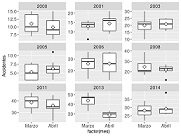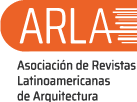Road accidents in Mexico and its relationship with daylight saving time
DOI:
https://doi.org/10.13140/RG.2.2.13733.81127Keywords:
summer schedule, circadian rhythms, road accidentsAbstract
The objective proposed in this work was to find out if there is a relationship between the beginning of summer time in Mexico and the number of road accidents, since the entrance of such schedule causes fatigue, which is reported as a cause of accidents. The permutations test was used and there was no evidence of an increase in accidents associated with the entry of summer time. The limitations of the study are, on the one hand, the lack of accident records prior to the implementation of summer time and, on the other, not having controlled the time of occurrence of the accidents analyzed; in future cases it is recommended to control this last variable. Summer time in Mexico was implemented since 1996 and its effects on road traffic accidents had not yet been studied; the originality of the present study lies in studying such effects. The findings suggest that vehicular driving with natural light provides greater safety even when the driver is fatigued
Downloads
References
INEGI, «Accidentes de tránsito terrestre en zonas urbanas y suburbanas. Consulta interactiva de datos», INEGI, 2016
W. Siraj y M. Roah, «Prevalence of Sleepiness as a Risk Factor for Road Traffic Accidents: Sample of Hospitalized Saudi Drivers», Med Sci, vol. 19, n°. 3, pp. 35–45, 2012
M. Kamstra, L. Kramer, y M. Levi, «Losing Sleep at the Market: The Daylight Saving Anomaly», Am. Econ. Rev., vol. 90, n° 4, pp. 1005–1011, 2000
I. Kirchberger et al., «Are daylight saving time transitions associated with changes in myocardial infarction incidence? Results from the German MONICA/KORA Myocardial Infarction Registry», BMC Public Health, pp. 3–8, 2015
A. Smith, «Spring Forward at Your Own Risk: Daylight Saving Time and Fatal Vehicle Crashes», Am. Econ. J. Appl. Econ., vol. 8, n° 2, pp. 65–91, 2016
T. Kantermann, M. Juda, M. Merrow, y T. Roenneberg, «The Human Circadian Clock’s Seasonal Adjustment Is Disrupted by Daylight Saving Time», Curr. Biol., vol. 17, n° 22, 2007
Instituto Nacional de Ciencias Médicas Generales (NIGMS), «Hoja informativa sobre los ritmos circadianos – National Institute of General Medical Sciences», nov-2012
C. Cajochen, S. Chellapa, y C. Schmidt, «Circadian and Light Effects on Human Sleepiness–Alertness», Sleepiness and Human Impact Assessment, Italia: Springer, 2014
Y. Inoue y Y. Komada, «Sleep loss, sleep disorders and driving accidents», Sleep Biol. Rhythms, vol. 12, pp. 96–105, 2014
Y. Kountouris y K. Remoundou, «About time: Daylight saving time transition and individual well-being», Econ. Lett., vol. 122, n° 1, pp. 100–103, 2014
D. Kuehnle y C. Wunder, «Using the life satisfaction approach to value daylight savings time transitions: Evidence from Britain and Germany», J. Happiness Stud., vol. 17, n° 6, pp. 2293–2323, 2016
T. A. Lahti, S. Leppämäki, J. Lönnqvist, y T. Partonen, «Transition to daylight saving time reduces sleep duration plus sleep efficiency of the deprived sleep», Neurosci. Lett., vol. 406, pp. 174–177, 2006
M. Berk, S. Dodd, K. Hallam, L. Berk, J. Gleeson, y M. Henry, «Small shifts in diurnal rhythms are associated with an increase in suicide: The effect of daylight saving», Sleep Biol. Rhythms, vol. 6, pp. 22–25, 2008
T. A. Lahti, J. Haukka, J. Lönnqvist, y T. Partonen, «Daylight saving time transitions and hospital treatments due to accidents or manic episodes», BMC Public Health, vol. 8, n°. 1, p. 74, 2008
P. Philip, C. Cyril, L. Nobili, y S. Garbarino, «Errors and Accidents», Sleepiness and Human Impact Assessment, Italia: Springer, 2014
Rey de Castro y E. Rosales –Mayor, «Monitoreo del sueño en conductores de ómnibus y camiones: factor relevante a considerar para la renovación de la licencia de conducir», Rev Peru Med Exp Salud Publica, vol. 27, n° 2, pp. 260–266, 2010
M. Goncalves et al., «Sleepiness at the wheel across Europe: a survey of 19 countries», J Sleep Res, vol. 24, pp. 242–253, 2015
D. Leger et al., «152 Insomnia and accidents: cross-sectional study (EQUINOX) on sleep-related home, work and car accidents in 5293 subjects with insomnia from 10 countries», J Sleep Res, vol. 23, pp. 143–152, 2014
A. Takashi, K. Yoko, A. Shoichi, O. Akiko, y I. Yuichi, «Questionnaire-based evidence of association between sleepiness while driving and motor vehicle crashes that are subjectively not caused by falling asleep», Sleep Biol. Rhythms, vol. 9, pp. 134–143, 2011
D. Bartels, K.Bhalla, S. Shahraz, J. Abraham, R. Lozano, y C. J. Murray, «Incidence of road injuries in Mexico: country report», Int. J. Inj. Contr. Saf. Promot., vol. 17, n° 3, pp. 169–176, 2010
Consejo Nacional para la Prevención de Accidentes, «Perfil estatal Querétaro», 2013
C. M. Barnes y D. T. Wagner, «Changing to daylight saving time cuts into sleep and increases workplace injuries» J. Appl. Psychol., vol. 94, n° 5, pp. 1305–1317, 2009
S. Neeraj y G. Arkadipta, «The Short and Long Run Effects of Daylight Saving Time on Fatal Automobile Crashes”, BE J. Econ. Anal. Policy, vol. 7, 2007
A. Smith, «Spring Forward at Your Own Risk: Daylight Saving Time and Fatal Vehicle Crashes», Am. Econ. J. Appl. Econ., vol. 8, n° 2, pp. 65–91, 2016
N. Holland y J. Hinze, «Daylight Savings Time Changes and Construction Accidents», J. Constr. Eng. Manag., vol. 126, n° 5, pp. 404–406, 2000
A. Huang y D. Levinson, «The effects of daylight saving time on vehicle crashes in Minnesota», J. Safety Res., vol. 41, n° 6, pp. 513–520, 2010
D. Coate y S. Markowitz, «The effects of daylight and daylight saving time on US pedestrian fatalities and motor vehicle occupant fatalities», Accid. Anal. Prev., vol. 36, pp. 351–357, 2004
M. P. Fay y P. A. Shaw, «Exact and asymptotic weighted logrank tests for interval censored data: the interval R package», J. Stat. Softw., vol. 36, n° 2, 2010

Published
How to Cite
Issue
Section
The opinions expressed by the authors do not necessarily reflect the position of the editor of the publication or UCLA. The total or partial reproduction of the texts published here is authorized, provided that the complete source and electronic address of this journal is cited. Authors have the right to use their articles for any purpose as long as it is done nonprofit. The authors can post on the internet or any other media the final approved version of their work.






.png)




